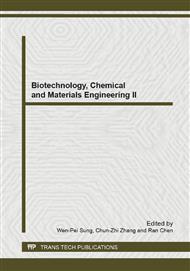p.975
p.979
p.984
p.988
p.993
p.997
p.1001
p.1005
p.1010
Fermentation of Carotenoid by Rhodotorula sp.D with the Utilization of Corn Steep Liquor
Abstract:
The fermentative production of carotenoid by Rhodotorula sp.D with the utilization of corn steep liquor were investigated at laboratory scale and then performed for industrial trial. The optimal inputs of waste syrup (glucose) and corn steep liquor of 7% and 33.3% were determined by single factor tests, with the highest carotenoid yeild of 11.7 mg/L and content of 383.6 μg/g (carotenoid/biomass) for 5L fermentation. The same conditions were then carried out in a 1000L fermentor for industrial trial. After 41 h fermentation, there were 31% of crude protein and 180.4 μg/g of carotenoid in the final spray dried products. These results show that as a non-expensive bioresource, corn steep liquor can be utilized for fermentative production of carotenoid, which will increase its potential as functional feed in industrial usage.
Info:
Periodical:
Pages:
993-996
Citation:
Online since:
January 2013
Authors:
Keywords:
Price:
Сopyright:
© 2013 Trans Tech Publications Ltd. All Rights Reserved
Share:
Citation:


